Denaturing CLIP, dCLIP, Pipeline Identifies Discrete RNA Footprints on Chromatin-Associated Proteins and Reveals that CBX7 Targets 3' UTRs to Regulate mRNA Expression
- PMID: 29073373
- PMCID: PMC5701755
- DOI: 10.1016/j.cels.2017.09.014
Denaturing CLIP, dCLIP, Pipeline Identifies Discrete RNA Footprints on Chromatin-Associated Proteins and Reveals that CBX7 Targets 3' UTRs to Regulate mRNA Expression
Abstract
Interaction networks between chromatin complexes and long noncoding RNAs have become a recurrent theme in epigenetic regulation. However, technical limitations have precluded identification of RNA binding motifs for chromatin-associated proteins. Here, we add a denaturation step to UV-crosslink RNA immunoprecipitation (dCLIP) and apply dCLIP to mouse and human chromobox homolog 7 (CBX7), an RNA binding subunit of Polycomb repressive complex 1 (PRC1). In both species, CBX7 predominantly binds 3' UTRs of messenger RNAs. CBX7 binds with a median RNA "footprint" of 171-183 nucleotides, the small size of which facilitates motif identification by bioinformatics. We find four families of consensus RNA motifs in mouse, and independent analysis of human CBX7 dCLIP data identifies similar motifs. Their mutation abolishes CBX7 binding in vitro. Pharmacological intervention with antisense oligonucleotides paradoxically increases CBX7 binding and enhances gene expression. These data support the utility of dCLIP and reveal an unexpected functional interaction between CBX7 and the 3' UTRs of mRNA.
Keywords: 3′ UTR; CBX7; CLIP; ChIP; PRC1; RNA; RNA interactome; bioinformatics; chromatin; epigenetics; polycomb.
Copyright © 2017 Elsevier Inc. All rights reserved.
Figures

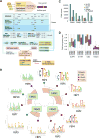
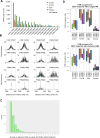
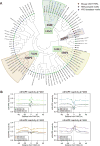
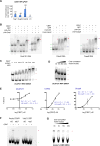

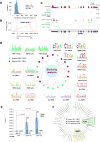
Comment in
-
Isolation versus Enrichment: dCLIP Enables Stringent Profiling of RNA-Binding Sites.Cell Syst. 2017 Oct 25;5(4):312-314. doi: 10.1016/j.cels.2017.10.007. Cell Syst. 2017. PMID: 29073369
Similar articles
-
Expression of ANRIL-Polycomb Complexes-CDKN2A/B/ARF Genes in Breast Tumors: Identification of a Two-Gene (EZH2/CBX7) Signature with Independent Prognostic Value.Mol Cancer Res. 2016 Jul;14(7):623-33. doi: 10.1158/1541-7786.MCR-15-0418. Epub 2016 Apr 21. Mol Cancer Res. 2016. PMID: 27102007
-
Mitogen-activated protein kinase signaling mediates phosphorylation of polycomb ortholog Cbx7.J Biol Chem. 2013 Dec 20;288(51):36398-408. doi: 10.1074/jbc.M113.486266. Epub 2013 Nov 5. J Biol Chem. 2013. PMID: 24194518 Free PMC article.
-
Live-cell single-molecule tracking reveals co-recognition of H3K27me3 and DNA targets polycomb Cbx7-PRC1 to chromatin.Elife. 2016 Oct 10;5:e17667. doi: 10.7554/eLife.17667. Elife. 2016. PMID: 27723458 Free PMC article.
-
PRC1 complex diversity: where is it taking us?Trends Cell Biol. 2014 Nov;24(11):632-41. doi: 10.1016/j.tcb.2014.06.005. Epub 2014 Jul 22. Trends Cell Biol. 2014. PMID: 25065329 Review.
-
How CBX proteins regulate normal and leukemic blood cells.FEBS Lett. 2024 Nov;598(22):2788-2806. doi: 10.1002/1873-3468.14839. Epub 2024 Mar 1. FEBS Lett. 2024. PMID: 38426219 Free PMC article. Review.
Cited by
-
RNAInter in 2020: RNA interactome repository with increased coverage and annotation.Nucleic Acids Res. 2020 Jan 8;48(D1):D189-D197. doi: 10.1093/nar/gkz804. Nucleic Acids Res. 2020. PMID: 31906603 Free PMC article.
-
The many faces of Polycomb regulation by RNA.Curr Opin Genet Dev. 2020 Apr;61:53-61. doi: 10.1016/j.gde.2020.02.023. Epub 2020 May 11. Curr Opin Genet Dev. 2020. PMID: 32403014 Free PMC article. Review.
-
R-Loops Enhance Polycomb Repression at a Subset of Developmental Regulator Genes.Mol Cell. 2019 Mar 7;73(5):930-945.e4. doi: 10.1016/j.molcel.2018.12.016. Epub 2019 Jan 29. Mol Cell. 2019. PMID: 30709709 Free PMC article.
-
Advantages and limitations of UV cross-linking analysis of protein-RNA interactomes in microbes.Mol Microbiol. 2023 Oct;120(4):477-489. doi: 10.1111/mmi.15073. Epub 2023 May 10. Mol Microbiol. 2023. PMID: 37165708 Free PMC article. Review.
-
Denaturing purifications demonstrate that PRC2 and other widely reported chromatin proteins do not appear to bind directly to RNA in vivo.Mol Cell. 2024 Apr 4;84(7):1271-1289.e12. doi: 10.1016/j.molcel.2024.01.026. Epub 2024 Feb 21. Mol Cell. 2024. PMID: 38387462 Free PMC article.
References
-
- Bag J, Bhattacharjee RB. Multiple levels of post-transcriptional control of expression of the poly (A)-binding protein. RNA Biol. 2010;7:5–12. - PubMed
Publication types
MeSH terms
Substances
Grants and funding
LinkOut - more resources
Full Text Sources
Other Literature Sources
Molecular Biology Databases

